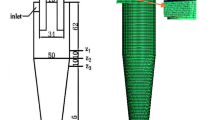Abstract
The fishhook effect, wherein the recovery of fine particles in the underflow increases with decreasing particle size, has been observed in hydrocyclone classification. A systematic study was carried out to determine the factors affecting the recovery of very fine particles to the underflow. Attempts were made to identify factors, i.e., design and operating variables, that affect the size at which this phenomenon occurs. Experimental results show that the sizes at which the fishhook effect occurs is mainly a function of feed size distribution and solids concentration and is less dependent on the design variables.
Similar content being viewed by others
References
Austin L.G., and Kumpel R.R., 1981, “An improved method of analyzing classifier data,” Powder Technology, 29, pp. 277–281.
Brookes, G.F., Miles, N.J., and Clayton, J.S., 1984, “Hydrocyclone performance related to velocity parameters,” 2nd Intl. Conf. On Hydrocyclones, pp. 67–81.
Del Villar, R., and Finch, J.A., 1992, “Modelling the cyclone performance with a size dependent Entrainment factor,” Minerals Engineering, Vol. 5, No. 6, pp. 661–669.
Finch, J.A., 1983, “Modelling a fishhook in hydrocyclone selectivity curves,” Powder Technology, Vol. 36, pp. 127–129.
Kelsall, D.F., 1953, “A further study of the hydraulic cyclone,” Chem. Eng. Sci., Vol. 2, pp. 254.
Leschonski, P., 1981, “Classification of Particles in Gases,” Int. Fine Particle Res. Inst. Report.
Luckie, P.T., and Austin, L.G., 1974, “Technique for the derivation of selectivity functions from experimental data,” Proc. 10th Int. Miner. Process. Congr., IMM, London, pp. 773–790.
Lynch, A.J., and Rao, T.C., 1975, “Modelling and scale up of hydrocyclone classifiers,” Proc. 11th Intl. Min. Proc. Cong., Cagliari, pp. 9–25.
Nageswararao, K., 1999, “Normalisation of the efficiency curves of hydrocyclone classifiers,” Minerals Engineering, Vol. 12, No. 1, pp. 107–118.
Verghese, P. Aby., 1988, “Characteristics of 76 mm dense medium cyclone,” Ph.D. Thesis, Indian School of Mines, Dhanbad, India.
Visman, J., 1966, “Bulk processing of fine material by compound water cyclones,” CIM bull., 59, No. 661, pp. 333–346.
Author information
Authors and Affiliations
Rights and permissions
About this article
Cite this article
Patil, D.D., Rao, T.C. Studies on the fishhook effect in hydrocyclone classification curves. Mining, Metallurgy & Exploration 18, 190–194 (2001). https://doi.org/10.1007/BF03403248
Received:
Revised:
Accepted:
Published:
Issue Date:
DOI: https://doi.org/10.1007/BF03403248




